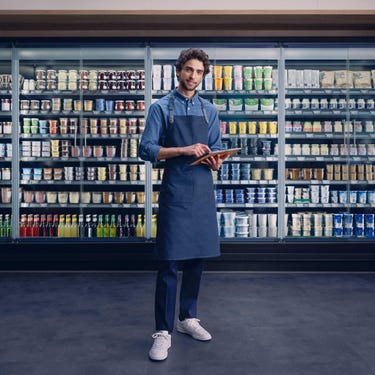
Why CO₂?

Peace of Mind
With our CO₂ scroll technology, we enable worry-free solutions tailored to your needs and ensure your peace of mind.
Good to Know – Global Warming Potential
Global Warming Potential (GWP) is the relative measure of how much heat a greenhouse gas traps in the atmosphere.
Retailers face challenges in choosing the best refrigerant and system architecture for their stores. They have to comply with stringent regulatory requirements for the use of future-proof technology, while also considering economic factors in their decision making.
Against Greenhouse Gases
Many new Hydrofluorocarbons refrigerants and system architectures have been introduced in the last decade to decrease the emissions of greenhouse gases and hence to reduce the global warming impact set by the Kyoto protocol. Commercial refrigeration has been in the environmental spotlight. Especially as leakage studies have revealed the true effects of Hydrofluorocarbons (HFCs) emissions in centralized systems. Although the leakage rate associated with this system architecture has now decreased, it remains somewhat high.
The F-Gas (EU) 517/2014 regulation is one of the most pressing issues of our industry today, imposing restrictions to refrigerant choice and therewith impacting system architecture. As the HFCs phasedown proceeds, players in commercial refrigeration are forced to identify truly sustainable alternatives that maximize the environmental, economic, and operational benefits.
The importance of CO2 (R-744) for refrigeration applications has increased in recent years. CO2 is termed a “Natural Refrigerant” because it exists in the natural environment. Released into the atmosphere from refrigerating systems, it has a negligible effect compared to other CO2 emissions sources that are driving the global warming debate: Compared to the fluorinated refrigerants alternatives it is natural, environmentally friendly, non-flammable, and cost effective in the long-term. R-744 is classified as safety class A1 according to ISO/ASHRAE standards. Its global warming potential is 3,922 times less harmful than R404A. The ban on R404A has been in force since January 1, 2020.
To Remember – The Kyoto Protocol and Kigali Amendment
In 1997, binding emission reduction targets were set for industrialized countries worldwide. The goal: to limit global warming, focusing on greenhouse gas emissions. In addition, in 2016, the Kigali Amendment to the Montreal Protocol of 1987 set an aggressive global phase-down schedule for HFCs. HFCs were introduced to replace Chlorofluorocarbons (CFCs) and Hydrochlorofluorocarbons (HCFCs). Because they are responsible for depleting the atmospheric ozone layer.
CO2 is the Future-Proof Refrigerant
Increasing environmental concerns about potential direct emissions into the atmosphere from HFC-based refrigeration systems have led to a revival of the carbon dioxide (CO₂) in the refrigeration market. Originally one of the first refrigerants used almost 100 years ago, its environmental benefits and properties qualify it as a good alternative for the present and the future.
| Trigger | Year | Refrigerants |
|---|---|---|
| Whatever Worked | End of 19th Century | Natural refrigerants such as NH3, CO2, SO2 etc. |
| Safety & Durability | 1930 - 1990 | CFCs and HCFCs |
| Ozone Depleting - Montreal Protocol | 1987 | Introduction of HFCs, Phase out of CFCs & HCFCs |
| Global Warming - Kyoto Protocol | 1997 | HFCs listed as potential greenhouse gases, Introduction of refrigerants with low GWP |
| Global Warming - European initiative F-Gas EC 842/2006 | 2006 | Containment and prevention to reduce emissions of the fluorinated greenhouse gases covered by the Kyoto Protocol |
| Global Warming - Review of EU F-Gas revision- EU 517/2014 | 2015 | Phase down of HFCs in EU down to 79% by 2030, alternatives natural refrigerants (CO2, NH3, HCs) and HFCs with low GWP |
| Global Warming - Kigali Amendment of Montreal Protocol | 2016 | Global phase down of HFCs |
| Global Warming - EU F-gas revision | Expected in 2023 | Alignment with Kigali Amendment to the Montreal Protocol and rising ambitions in line with EU green deal |

The use of CO₂ as a natural raises many questions: aren't CO₂-based solutions large, complex, and costly? Are they suited for use in hot environments? Does CO₂ pose safety risks during operation? And after all, isn't it a greenhouse gas harmful to the environment? Based on our extensive expertise in refrigeration technology, we set the record straight.
CO₂ is a leading option for environmental reasons. Positive experience has been gained with different system configurations over many years, particularly in central and northern Europe. The confidence resulting from this experience ensures that CO₂ will be a long-term option in the foreseeable future.
Under Pressure
The main difference with traditional refrigerants is the very low critical temperature, 31 °C for CO₂ (R-744). Therefore, the process of heat rejection to the environment does not usually imply condensation of carbon dioxide. Much more it is a dense gas progressive cooling at a constant pressure higher than the critical pressure (subcritical cycle). This of course happens unless a heat sink is available at low temperatures (generally below 20 °C). In this case the refrigerant cycle is subcritical and similar to the traditional refrigerant’s cycle.
CO₂ refrigerating systems require higher compression pressure compared to systems with commonly used refrigerants. The entire systems and their components must be designed accordingly.
The triple point of CO₂ occurs at 4.2 bar (g). Below this point there is no liquid phase. At atmospheric pressure solid R-744 sublimes directly to a gas. In solid state it has a surface temperature of -79°C. If R-744 is at a high pressure and reduced to a pressure below the triple point it will deposit directly to a solid. This process is known as dry ice.
What Sets R-744 apart
Comparisons between R-744 and other refrigerants can be misleading because of R-744’s low critical temperature. R-744 compares reasonably well with the HFCs when the cycle is subcritical. But at high ambient temperature when the cycle becomes transcritical it does not. What you should also know:
CO₂ (R-744) has a high refrigeration capacity due to its high volumetric cooling capacity. Approximately up to 5 times that of R-404A.
This has a positive impact on compressor displacement and the sizing of heat exchangers and pipe work.
The compression ratio for R-744 is less than that for HFCs. This can result in higher isentropic efficiency of the compressor.
R-744 has a high heat transfer performance due to the high pressure, high density and good thermophysical properties. These are high thermal conductivity, the large value of the specific heat capacity of the liquid, and low values of the kinematic viscosity.
This results in lower temperature differences between the refrigerant and the secondary fluid, thus improving system efficiency.
The Best of Two Worlds
Nowadays, sourcing the necessary equipment of systems operated with CO₂ is no longer a difficulty. High investment costs were characteristic of early CO₂ projects, but these costs are now on a downward trend. The refrigerant itself comes at a fraction of the cost of some dedicated HFCs.
CO₂ is the refrigerant of choice due to these many advantages. Its continued success as a leading refrigerant is now being driven further by a technological leap. Intensive research and development, investment and technical know-how have led to the most awaited innovation of the industry: We succeeded in applying scroll technology to CO₂ as a refrigerant in medium and low temperature applications. Thus, making the best of both worlds widely available.
Refrigerant of Choice
Our innovative CO₂ scroll compressors make the natural refrigerant easy and economical to use in small to medium supermarket sizes and enable for large-scale rollout in all world regions. In conjunction with the innovative compressor range, we have also developed a new a line of refrigeration units that combine this cutting-edge scroll technology with smart electronics.




